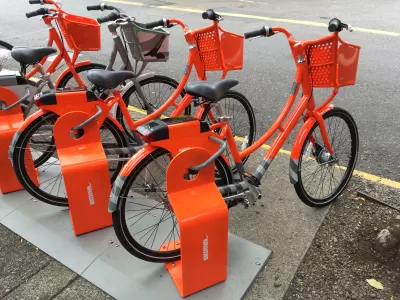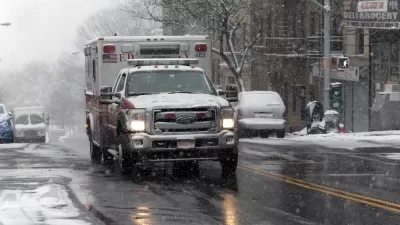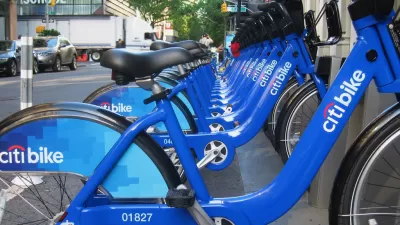Bikeshare programs were first introduced in the U.S. seven years ago. Outside Magazine investigates whether they "are actually benefiting cities and their residents."

"What metrics should we use to determine whether the concept itself is a success?" asks Joe Lindsey.
A good place to start is to look at the three major factors that Zoe Kircos, director of grants and partnerships for advocacy group People for Bikes, says are the primary goals of bike sharing: reducing traffic congestion, boosting public health, and increasing mobility.
Lindsey cites three studies that provide some answers:
- [A] 2014 report from the NYC Department of Transportation found that even though some traffic lanes were converted to protected bike lanes on various streets, travel times for car traffic remained steady or improved: on Eighth Avenue, they were 14 percent faster, for example.
- A 2015 study in Transport Reviews looked at systems in five cities, including Washington, D.C., and Minneapolis, and found that users substituted rides via bike shares for car trips 8 percent of the time in D.C. and almost 20 percent of the time in Minneapolis.
- A separate study on D.C.’s Capital Bikeshare found that it contributed a modest but noticeable 2 to 3 percent reduction in traffic congestion.
The last two studies was undertaken about a year before the onset of the SafeTrack repair program, which reduced operating hours of the D.C. Metro. "The number of trips since the beginning of SafeTrack in June increased about 7 percent compared with June to November 2015," reports Planetizen's Casey Brazeal on November 28.
"One-day and single-trip fares are also up about 58 percent compared to pre-SafeTrack numbers," Luz Lazo [in the Washington Post] tells us.
Safety and Public Health
Lindsey also looks into the public safety and health aspect of the programs, citing two studies that show that while biking as a whole may be seeing increasing fatalities in the U.S., that's not the case for bikeshare:
- [A] recent study of New York’s Citi Bike program in BMJ’s journal Injury Prevention found that the city’s addition of bike lanes, crucial to Citi Bike’s success, increased lifespan even among nonusers because of the reduction in pollution.
- [A] report on London’s massive bike-share system found injury rates for bike-share users were lower than those for regular cyclists.
- In the U.S., there has been one bike-share rider death in the system’s seven-year history. By contrast, roughly 700 cyclists die each year on America’s roads.
An April post looks into why bikeshare cycling has a better track record than regular cycling, notwithstanding the lack of helmet availability.
Subsidies
Lindsey also looks at one of bikeshare's criticisms: public funding. For the three different operating models (which he delineates), the public subsidy varies from small to none, as opposed to the huge subsidies that many public transit receives per ride, making many of the criticisms moot.
Not only are bike shares achieving statistically measurable improvements in traffic congestion and public health, they’re doing so at negligible cost to taxpayers.
Deficiencies
Another criticism is that bike share doesn't serve a diverse population, particularly minorities, low-income communities, and even women, despite the availability of discounted membership in some programs. Ford GoBike has announced a $5 discounted annual membership to attract low-income users to its Bay Area program when it launches in the Spring, though it only applies for the first year.
And not all bike shares have been financially successful, resulting in their discontinuance.
These failures have allowed developers to realize that bike-share programs work best at “scale and density,” according to Kate Fillin-Yeh, who helped launch Citi Bike and now directs the bike-share program at the National Association of City Transportation Officials (NACTO).
"So, is the concept of bike share as a whole a success?" asks Lindsey.
Despite some imperfections, there are very few arguments from users, researchers, or advocates that a bike-share system is bad for a city. But to better quantify the role it plays in the United States, we simply need more frequent and rigorous data and analysis, like the London study.
Hat tip to Melanie Curry of Streetsblog California.
FULL STORY: Do Bike Share Systems Actually Work?

Planetizen Federal Action Tracker
A weekly monitor of how Trump’s orders and actions are impacting planners and planning in America.

Congressman Proposes Bill to Rename DC Metro “Trump Train”
The Make Autorail Great Again Act would withhold federal funding to the system until the Washington Metropolitan Area Transit Authority (WMATA), rebrands as the Washington Metropolitan Authority for Greater Access (WMAGA).

The Simple Legislative Tool Transforming Vacant Downtowns
In California, Michigan and Georgia, an easy win is bringing dollars — and delight — back to city centers.

The States Losing Rural Delivery Rooms at an Alarming Pace
In some states, as few as 9% of rural hospitals still deliver babies. As a result, rising pre-term births, no adequate pre-term care and "harrowing" close calls are a growing reality.

The Small South Asian Republic Going all in on EVs
Thanks to one simple policy change less than five years ago, 65% of new cars in this Himalayan country are now electric.

DC Backpedals on Bike Lane Protection, Swaps Barriers for Paint
Citing aesthetic concerns, the city is removing the concrete barriers and flexposts that once separated Arizona Avenue cyclists from motor vehicles.
Urban Design for Planners 1: Software Tools
This six-course series explores essential urban design concepts using open source software and equips planners with the tools they need to participate fully in the urban design process.
Planning for Universal Design
Learn the tools for implementing Universal Design in planning regulations.
Smith Gee Studio
City of Charlotte
City of Camden Redevelopment Agency
City of Astoria
Transportation Research & Education Center (TREC) at Portland State University
US High Speed Rail Association
City of Camden Redevelopment Agency
Municipality of Princeton (NJ)





























